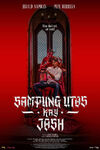REVIEW: On its third staging, The Necessary Theater’s ‘Red’ by John Logan is as relevant as ever
Disclaimer: John Logan’s ‘Red‘ is probably one of my favourite plays of all time. I’ve seen it twice before, as staged by Bart Guingona ten years ago also for The Necessary Theater. He produced it once at the SDA Theater in Benilde in 2013 and again in the CCP in 2014, both with Joaquin Valdez. My attachment to the play and its earlier productions have given me a different insight into Logan’s very cerebral, very articulate play about a fictional hypothesis of why celebrated abstract impressionist Mark Rothko returned a then-very lucrative 35,000 dollar commission to paint murals in the Seagram building’s bougie Four Season restaurant, which rocked the art world in that period.

Running approximately 90-minutes with no intermission, ‘Red’ is a two-hander, with Bart Guingona playing the eccentric painter and JC Santos playing the fictional assistant Ken, who comes to work with Rothko at the time of the painting of the Seagram murals. Broken down into scenes, the play becomes a means by which Rothko can openly discuss his views on art and commercialism and consumerism and the then-modern world’s deterioration in its ability to “be human.” In the play, Rothko is deftly smart and unafraid to lord it over his new assistant. He lashes out and asks Ken to “be a human being for once in your life” while asking the same assistant to “be kind” to his paintings.
Ten years ago, Guingona approached this role with a bit of humor. There was a knowing delivery in the way that his Rothko went at Ken. But with Santos eager, bright-eyed Ken looking so vulnerable and fragile, it brings out the cruelty in Guingona’s new approach. He’s mean. He’s condescending. Ten years have aged Guingona’s approach and there’s a world weariness to his Rothko that is emphasized later on in the play when he starts to feel attacked by the pop artists like Warhol and Lichenstein who have begun to take the art world by storm.
The play is didactic. Rothko and Ken argue, debate, and discuss the intricacies of the color red, Rothko’s own vision and belief about art and culture, and the world’s movement away from all things sophisticated and high brow. Through it, we also investigate the complex relationship between the two characters as Rothko inadvertently becomes mentor, friend, and even father figure to the young Ken, something which he explicitly says he isn’t at the very start.

What makes all of these nuanced shifts and tonal changes apparent is Santos’ portrayal of Ken. As mentioned, he opens the play doe-eyed and innocent but as each scene unfolds, he adds new layers to his relationship with Rothko. He is more comfortable with him as time passes – at first he deigns to ask questions, his posture shifts, the way he looks at the master artist tempers down and then later, he stands his ground and even answers back, he can look at Rothko in the eye and not flinch – the way by which Santos conveys the passage of time is so distinct that it makes the play. Unfortunately, Guingona has chosen to portray Rothko at a fixed point. He doesn’t change except for the ending when he manages to bring out a vulnerability Guingona wasn’t able to tap in earlier productions, it’s only at the finale that he becomes human. But throughout the first three quarters of the play, his approach feels of one note.
And there’s a mannered direction to their line delivery. It’s as if Guingona, who also directs the play, leans heavily into the theatricality of the material. Both characters are very eloquent and very articulate. The mannered way of line delivery lends very well to the moments when the characters enter into their monologues. By emphasizing the scriptedness of the play, the message of the play really jumps out. But there’s also a tension that is created when the play also obsesses over the workings of painting. While talking, the two are engaged in busy-ness. Santos is either always mixing paint or setting up a canvas. The canvasses are huge too and the pair must navigate the cluttered set to move things around. Oftentimes, the stage feels too small for their movements but it helps create this tension of organic activity with the theatricality of the performances.
And the play is as relevant as it ever was! This is an age where AI technology threatens to replace artists and the making of art. This is an age where the new generation boasts of such short attention span that they seem unable to handle overwhelmingly heavier things. This is an age of smart shaming and a changing of the guard. In a way, ‘Red’ as a play becomes a cultural signpost – an anchor, if you will – that reminds us to not be afraid of knowledge and to ask more from the world. To not just settle for “pretty pictures” but to grapple with the stuff of life so passionately.
My Rating:

Don’t miss out on the final weekend of RED, John Logan’s play, in Manila. Catch the remaining shows on June 16 at 8pm, June 17 at 3pm and 8pm, and June 18 at 3pm and 8pm. These are the last 5 shows! RED is currently being staged at PETA. Secure your tickets now by purchasing them here.





![(G)I-DLE World Tour [iDOL] In Cinemas](https://cdn1.clickthecity.com/images/movies/poster/20413.jpg)














